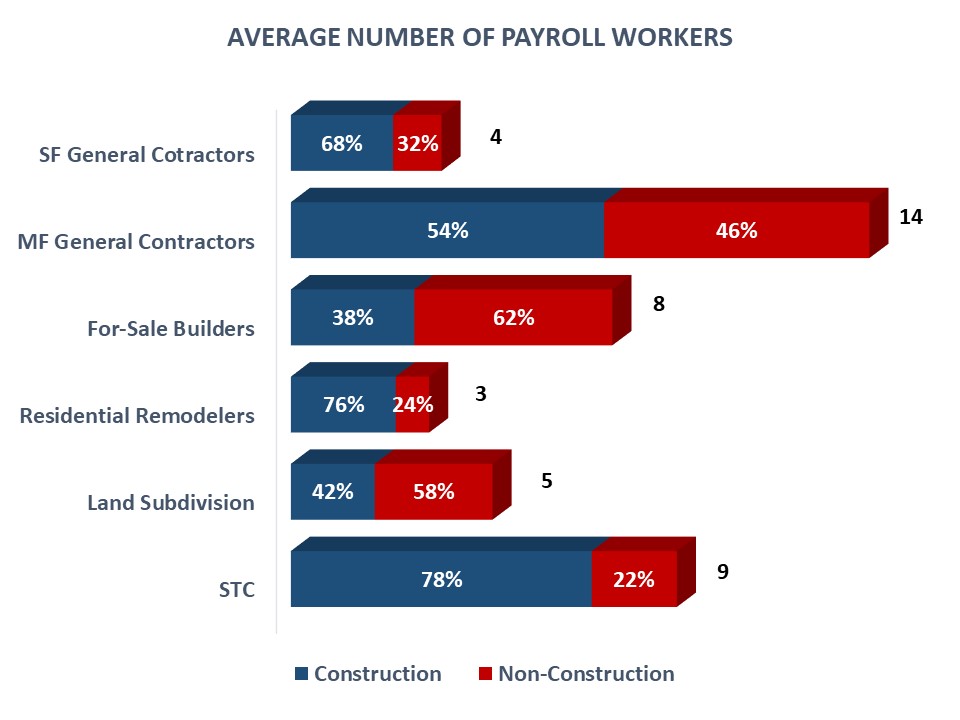New NAHB research shows that despite declining self-employment rates and the rising top builder market share, residential construction remains the industry of independent entrepreneurs with close to 80% of homebuilders and specialty trade contractor firms being self-employed independent contractors. Even among firms with paid employees, the industry continues to be dominated by small businesses, with 63% of homebuilders and two out of three specialty trade contractors generating less than 1 million dollars in total business receipts. The new estimates are based on the 2017 Economic Census data.
Among residential construction businesses with paid employees, remodeling, land subdivision and specialty trade subcontractors (STC) companies tend to be smaller. 78% of remodeling establishments, 68% of land developers and two out of three STC companies generate under $1 million in receipts.
Homebuilders are typically somewhat larger with about 37% of companies reporting annual sales in excess of $1 million. Among homebuilders, multifamily general contractors tend to be largest, with more than 57% of companies generating over $1million and about one out of three companies generating over $5 million in 2017. 23% of multifamily general contractor establishments crossed the $10 million mark.

Single-family contractors (SFC) are often smaller compared to for-sale builders (who build on land they own and control). Less than a third of single-family contractors reported annual sales in excess of $1 million while over half of for-sale builders crossed the million dollar mark. Focusing on the top earners shows that 15% of for-sale builders but only 3% of SFC made over $10 million in total business receipts in 2017.
Under the most recent US Small Business Administration (SBA) size standards, the vast majority of residential construction companies qualify as a small business. The most recent small business size limits for all types of builders is $39.5 million, for land subdivision is $30 million, and $16.5 million for specialty trade contractors. By these standards, almost all remodelers and single-family contractors and at least 98% of land developers, and 96% of specialty trade contractors easily qualify as a small business.
Home building establishments are highly specialized and subcontract out a significant portion of the construction work to subcontractors who can more efficiently perform specific construction activities. Single–family general contractors and spec builders subcontract out more than a quarter (over 27%) of their construction work. Multifamily general contractors subcontract out most of their construction work, over 51%. Specialty trade contractors who, by definition, specialize in specific activities (e.g., pouring concrete, site preparation, plumbing, painting, and electrical work) subcontract out less than 8% of the work. The cost of materials purchased by establishments for subcontractors is not included in the cost of construction work subcontracted out to others. Rather, it is captured in the net (in-house) value of construction work.  Because residential construction establishments are highly specialized and subcontract out a significant portion of construction work to others, they maintain relatively few construction workers on their payrolls, including both full-time and part-time workers. Single-family general contractors on average have four employees on their payroll.
Because residential construction establishments are highly specialized and subcontract out a significant portion of construction work to others, they maintain relatively few construction workers on their payrolls, including both full-time and part-time workers. Single-family general contractors on average have four employees on their payroll.
Residential remodelers have 3 to 4 workers, and speculative builders’ payrolls average 8 workers over the course of a year. Multifamily general contractors and specialty trade contractors maintain largest annual payrolls, averaging more than 14 and 9 workers over the course of the year, respectively.
Two out of three employees on payrolls of single-family general contractors are construction workers directly engaged in construction operations, such as painters, carpenters, laborers, plumbers, and electricians. For residential remodelers, this share is even higher, with 3 out of 4 payroll employees being construction workers. The rest are non-construction workers, including supervisory employees above the working foreman level, purchasing, accounting, personnel, and professional and other office functions. For corporations, executives and salaried officers are included in the non-construction payroll. For unincorporated businesses, proprietors and partners are not counted as paid employees with their earnings being captured in the residual profit rather than in the payroll.
Specialty trade contractors register the highest share of construction workers on their payrolls – 78%. Speculative builders stand out for keeping disproportionally low share of construction workers on their payrolls – 38%. The remaining 62% of their employees are non-construction workers.  The complete NAHB report is available to the public as a courtesy of Housing Economics Online.
The complete NAHB report is available to the public as a courtesy of Housing Economics Online.
Discover more from Eye On Housing
Subscribe to get the latest posts sent to your email.
